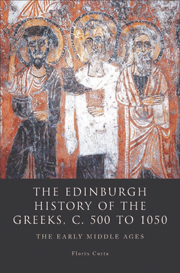Book contents
- Frontmatter
- Contents
- List of Illustrations
- List of Tables
- Acknowledgements
- Series Editor's Preface
- Introduction
- 1 The last century of Roman power (c. 500 to c. 620): army, church, and countryside
- 2 Collapse or adaptation? The problem of the urban decline in late antique Greece
- 3 Invasion or inflation? Hoards and barbarians in sixth- and early seventh-century Greece
- 4 Dark-Age Greece (c. 620 to c. 800)
- 5 Revival and expansion (c. 800 to c. 900)
- 6 The beginning of prosperity (c. 900 to c. 1050)
- 7 Early medieval Greece and the Middle Byzantine economy
- 8 Social structures and Byzantine administration in early medieval Greece
- 9 Christianity in early medieval Greece
- 10 Conclusion: the people of early medieval Greece
- Bibliography
- Index
5 - Revival and expansion (c. 800 to c. 900)
Published online by Cambridge University Press: 05 August 2013
- Frontmatter
- Contents
- List of Illustrations
- List of Tables
- Acknowledgements
- Series Editor's Preface
- Introduction
- 1 The last century of Roman power (c. 500 to c. 620): army, church, and countryside
- 2 Collapse or adaptation? The problem of the urban decline in late antique Greece
- 3 Invasion or inflation? Hoards and barbarians in sixth- and early seventh-century Greece
- 4 Dark-Age Greece (c. 620 to c. 800)
- 5 Revival and expansion (c. 800 to c. 900)
- 6 The beginning of prosperity (c. 900 to c. 1050)
- 7 Early medieval Greece and the Middle Byzantine economy
- 8 Social structures and Byzantine administration in early medieval Greece
- 9 Christianity in early medieval Greece
- 10 Conclusion: the people of early medieval Greece
- Bibliography
- Index
Summary
‘Nikephoros was holding the scepter of the Romans, and these Slavs who were in the province of Peloponnesus decided to revolt.’ They first attacked their Greek neighbours, whose settlements they plundered, and then laid siege to the city of Patras, ‘having with them African Saracens also’. Shortage of both food and water persuaded the inhabitants of Patras to consider the option of surrender. However, before doing so, they decided to try one more thing. Since the leaders of the city (archontes) had already informed the military governor (strategos), who at that time was in Corinth, about the attack of the Slavs, the Patraeans sent a scout ‘to the eastern side of the mountains’ in order to see if the military governor was indeed coming to their rescue. If he were to see the troops of the military governor approaching, the scout was to return to the city and dip his standard, but if not, he was to hold the standard straight, ‘so they might for the future not expect the military governor to come’. The scout did not see anyone coming and was about to return to Patras with the standard erect when, through the intercession of St Andrew, God made his horse slip and the rider fell off, in the process dipping the standard. Emboldened by what they took to be good news, the Patraeans attempted a sortie against the Slavs. At this point, they saw St Andrew, ‘mounted upon a horse and charging upon the barbarians’, whom he routed and scattered and drove away from the city.
- Type
- Chapter
- Information
- The Edinburgh History of the Greeks, c. 500 to 1050The Early Middle Ages, pp. 135 - 165Publisher: Edinburgh University PressPrint publication year: 2011



